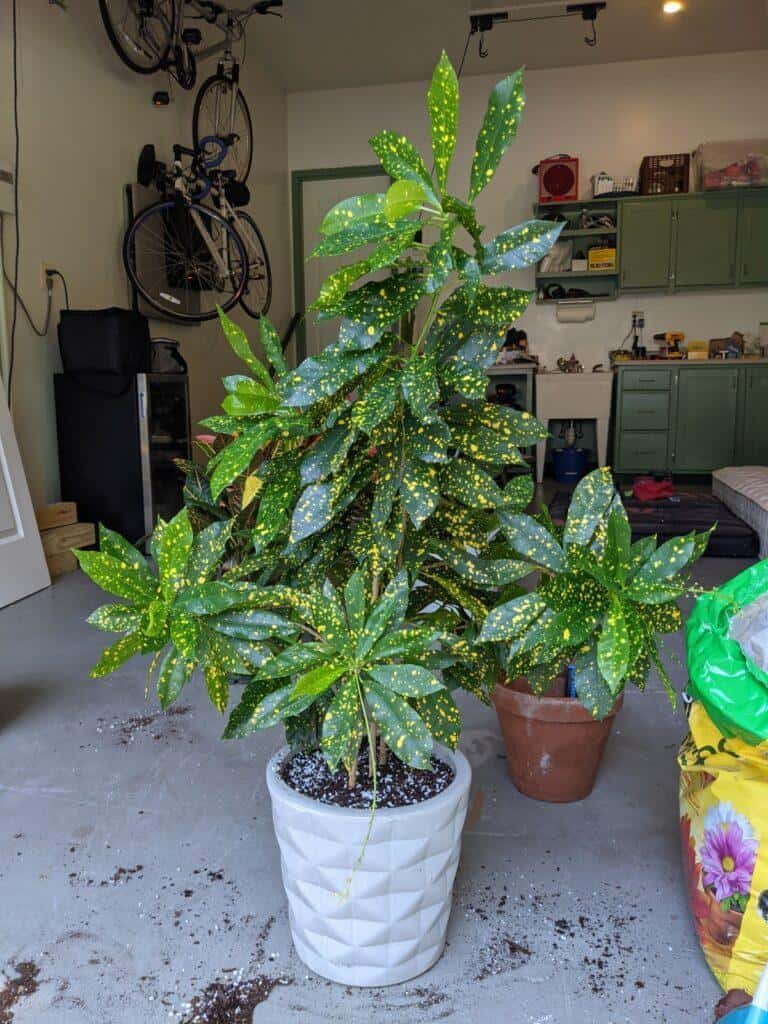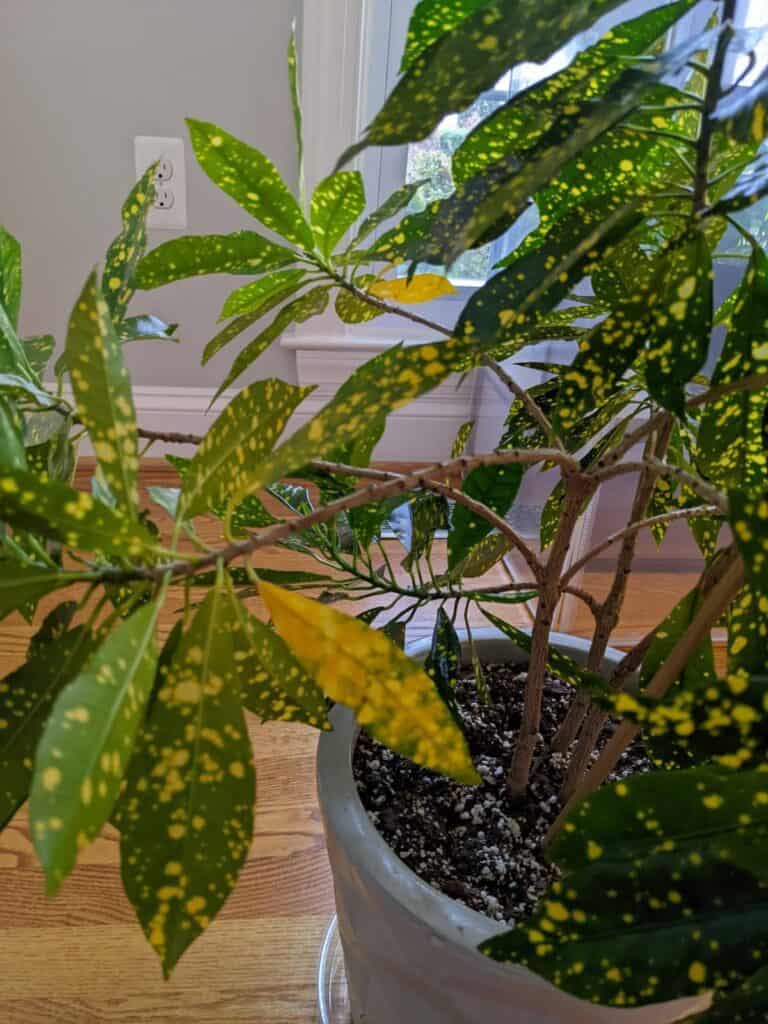How to Fix Your Gold Dust Croton Yellow Leaves
From time to time my Gold Dust Croton gets yellow leaves. This post will cover some scenarios in which you might encounter yellow leaves on your Gold Dust Croton. I will also cover some recommendations to address the yellow leaves to make sure your Croton stays healthy.
About Gold Dust Croton
Crotons are a popular houseplant often found at home improvement stores and nurseries. They come in a wide variety. They vary in leaf size, leaf shape, and typically sport a colorful leaf pattern. The Gold Dust specifically has green leaves that are on the smaller side and they are speckled with yellow dots, or gold dust if you will. Gold Dust Crotons require a lot of light. They do best in a south-facing window where it will get abundant light. When Gold Dust Crotons don't receive adequate light the leaves will not have as many of the tell-tale yellow speckles.
| Light Needs | Watering Needs | Soil Needs | Fertilizing Needs |
| Bright indirect light. | The top inch of soil should be dry before watering. | Well draining potting soil. | Every 2- 4 weeks during the growing season. |
Gold Dust Crotons are relatively slow-growing. I have had mine for about seven years. In that time, it has grown from about eight inches to close to three feet. Below is a picture of my Gold Dust Croton from a repotting post I did earlier this year. They are also not safe for your dog or cat to ingest, so keep them out of reach.

What Causes Gold Dust Croton Yellow Leaves?
Water Issues Can Cause Yellow Leaves
Both over and underwatering can cause your Gold Dust Croton to have yellow leaves. For me, the best way to tell if there are water issues is to use a soil moisture meter. Something simple like this soil moisture meter will do the trick. You can also use your finger.
I sometimes end up underwatering my Gold Dust Croton. For me, it's easy to spot because the leaves of the whole plant seem a little droopy. And typically the leaves that turn yellow are at the base of a stem. These are the older leaves and tend to be more susceptible to drying out. You can see some examples in the photo below.

If your soil feels moist and the yellow leaves are more disbursed and not concentrated at the base of the stems, then you may be dealing with overwatering.
How to Fix Water Issues
If you are underwatering, it's pretty straightforward. Water your plant. Don't overdo it though, you could go too far the other way. The yellow leaves on your Gold Dust Croton will not regain their color though. You can let them fall off or pull them off if you want to. If the water just runs through your plant because it was previously underwatered, you may need to water from the bottom. That just means to stick your plant pot in a bowl or the sink with water and the soil and roots soak up water from the base of the plant.
If you have overwatered, it will be more complicated. The first thing you want to do is remove your Gold Dust Croton from its pot. That will let the root ball and soil dry more quickly. Once the root ball has dried enough to handle, you need to inspect the roots for rot. They will appear brown and feel mushy. If you have rotten roots you need to cut them away with a clean sharp knife. Then you can repot your Gold Dust Croton in new soil and hope for the best. I have a whole post dedicated to fixing an overwatered plant if you want to follow along in more detail.
Fertilizing Issues Can Yellow Leaves
Just like you can over and underwater, you can also over and under fertilize. However, yellow leaves specifically are more likely to do with under fertilization. Overfertilized plants are more likely to exhibit slow growth and maybe wilting. Typical houseplant fertilizers have a balanced ratio of nitrogen, phosphorous, and potassium, or n-p-k, which you see on the label of plant fertilizer. Yellow leaves can be a symptom of a lack of nitrogen or phosphorous. Nitrogen specifically helps leaf growth.
Fertilization issues should affect all the leaves on the plant equally. Other signs that you have a fertilization issue can be slow growth. You can use soil rapitest which allows you to test for ph and each nutrient individually. It's the only way to be totally sure you have a nutrient deficiency, and if you have a lot of plants it's a good investment.
How to Fix Fertilization Issues
If you have overfertilized your Gold Dust Croton, the best thing to try is to flush the soil by watering it a lot. You may even want to remove the plant from its pot because you don't want to end up overwatering either.
To fix an under fertilized plant you will need to fertilize. Water-soluble or liquid fertilizers work best for quicker absorption. If you don't opt for a soil rapitest that I linked earlier, it would be best to stick with a balanced fertilizer that has the same number in the n-p-k ratio. If you know from the tests that you specifically have nitrogen or phosphorous deficiency, then you can find fertilizers that have higher ratios of the nutrient you need. Whatever you do, follow the instructions on the fertilizing product. Some require dilution or that you water the plant beforehand.
Pests Can Cause Yellow Leaves
A wide variety of pests can attack indoor plants. The big ones that attack foliage, causing yellowing, are aphids, scale/mealybugs, spider mites, and thrips. These pests pierce your leaves to feed and ultimately destroy them. Yellowing leaves from pests may appear spotty where the pests have attacked. That's a not super helpful tip for a Gold Dust Croton because they are supposed to have yellow spots. If you think you might have pests the best thing you can do is a close visual inspection of your plant. Use a flashlight to help you see contrast and shadows. Pay close attention to the underside of the leaves.
How to Fix Pest Issues
If you have pests, first quarantine your plant away from other healthy uninfested plants. Next, you'll need a multipronged approach to address pests. The first order of business is removal. Most pests can be removed by a strong spray in the shower or with a hose. Others like scale and mealybugs require manual removal.
Next use an insecticide. There are organic versions like neem oil that seem to do well. I have personally used neem oil on spider mites successfully. Nonorganic insecticidal soap also works well on these pests. The most important thing to do is to repeat these steps until you do not detect pests for over a week. Pests have short lifecycles so although you don't see them their eggs may still remain.
Hopefully, this helps you diagnose your Gold Dust Croton's reason for yellow leaves and now you can begin your journey to fix it. Have any questions? Post them in the Comments section below.
Add new comment